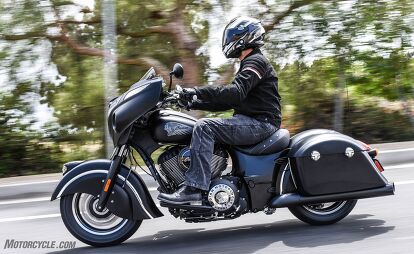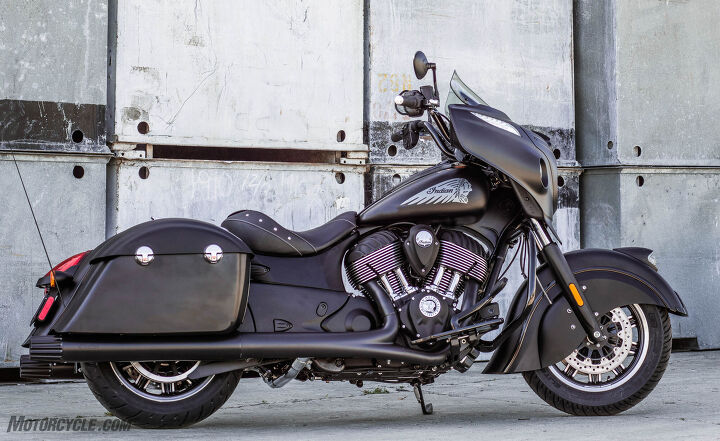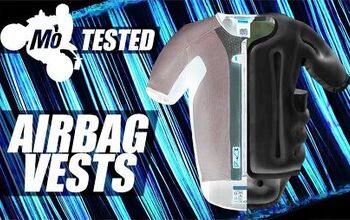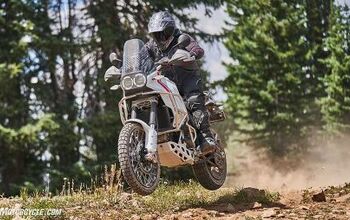2016 Indian Thunder Stroke 111 Factory Hop-Up

We’ve ridden the Indian Chieftain a few times, and we’ve always been fond of its engine and power delivery. Still, the semi-secret, unofficial MO Motto is “More is more.” So, when the Indian PR folks asked us which model Chieftain Dark Horse we wanted to take home to cuddle up with, a stocker or one that had been blessed with the complete listing from the factory performance catalog, you can probably guess our answer. Then toss in the fact that, with the exception of the model-specific exhaust, all of these modifications could be made to any Thunder Stroke 111 engine, and we saw the opportunity to share our bounty with our readers.
The Goods
Naturally, you’re curious about what the Indian Parts & Accessories department have cooked up. So, without further ado, we’ll move through the engine along the same path as the atmosphere would. The Thunder Stroke High Flow Air Cleaner – Black retails for a surprising $499.99 and allows the beefy V-Twin to breathe deep without endangering small birds or children. The removable filter element can be washed to maintain the engine’s peak performance, and the 1-inch narrower profile gives the rider a little extra room on the left side of the engine. Finally, the blacked out style matches the Dark Horse’s look perfectly. Still, $500 for an air cleaner?
To take advantage of the freer-flowing intake, the Indian Motorcycle Stage 2 Performance Cams offer a claimed increase of 13% horsepower and 7% torque all while maintaining 50-state emission-compliance. Throttle response will also be significantly increased. These $499.99 cams can only be bought at an Indian dealer and must be used in conjunction with the aforementioned air cleaner and matching Indian slip-ons. The why of this requirement is that the modifications require the EFI to be recalibrated for emissions compliance. Additionally, having the parts installed and the EFI updated by a dealer maintains the factory powertrain warranty. The loss of warranty is one of the big compromises of going to the aftermarket.
The final pieces of the puzzle are the exhaust modifications. All of these parts are available in both chrome and blacked out, so if you want to maintain the chrome exhaust instead of the fully-blacked-out look of our Dark Horse, the cost will be a bit less. The functional components are contained in the $699.99 Touring Thunder Stroke Stage 1 Slip-on Exhaust Kit. These dual mufflers attach to the factory headers (hence the slip-on name) and allow more prodigious exhaust flow. Still, according to Indian, they maintain 50-state compliance – which is quite a feat. If you’re changing the finish of the exhaust, you’ll need to add the $279.99 Exhaust Shields (black, in our case). The slip-ons also require the purchase of exhaust tips, which range from $199.99-$299.99. The Six Shooter Exhaust Tips shown here check in at the top of the scale.
The Results
After even a short ride on the stock Chieftain Dark Horse, stepping onto the hopped-up version is a revelation. The throttle response is quite snappy with the more muscular low-rpm torque apparent from the saddle. And then there’s the exhaust note!
Around town, the throaty sound is more than pleasing to the ear – though bordering on a little loud for my delicate sensibilities. I’m particularly cognisant of the sound when entering or leaving my driveway in my very quiet neighborhood early in the morning or late at night. Although the motorsports-crazy grandmother next door did shout to me from her front porch, “What is that new bike you’re testing? I love the sound!” I figure that not all of my neighbors spend their weekends watching two races at once (thanks to PIP). So, I try to keep the revs down on my street. Venturing onto the freeway or out into the countryside highlights the Thunder Stroke’s basso profondo.
Whacking open the throttle in an environment where you can run out the engine reveals power that keeps on building throughout the rev range. My only quibble is that neutral throttle is more difficult to hold at lower rpm – like when poking along in stop-and-go traffic. Since this does not translate over into engine speeds at which riders typically corner, the chassis is never upset, relegating this criticism to the type that motojournalists are paid to complain about.
The dyno chart illustrates how at every engine speed both the horsepower and torque are greater than that of the stocker. The slight dip in both graphs around 2,000 rpm is unnoticeable from the saddle. While the 18% increase in horsepower exceeds Indian’s claims about the performance gain, we need to stress that the before numbers did not come from the same bike prior to the changes. Rather, they were from our previous test of the Chieftain run on the same dyno. Updates to the stock EFI in the current model year Thunder Stroke 111 or simple variations in manufacturing tolerances could have slightly decreased the stock numbers and inflated the percentage of change. Still, the peak torque of 113.1 lb-ft is a 10% bump. What is most noticeable, however, is how the gap between the stock and modified curves increase throughout the rev-range for both horsepower and torque, showing the engine’s improved breathing ability. The tested 38.0 mpg is pretty respectable for a modified bike, too.
So, if you’re the type of rider for whom the MO More philosophy applies and you’re willing to pony up $2,280 plus labor, you will probably be quite happy with the upgrades. The price may be steep, but it will pay dividends every time you twist the throttle.

Like most of the best happenings in his life, Evans stumbled into his motojournalism career. While on his way to a planned life in academia, he applied for a job at a motorcycle magazine, thinking he’d get the opportunity to write some freelance articles. Instead, he was offered a full-time job in which he discovered he could actually get paid to ride other people’s motorcycles – and he’s never looked back. Over the 25 years he’s been in the motorcycle industry, Evans has written two books, 101 Sportbike Performance Projects and How to Modify Your Metric Cruiser, and has ridden just about every production motorcycle manufactured. Evans has a deep love of motorcycles and believes they are a force for good in the world.
More by Evans Brasfield










































Comments
Join the conversation
These cruisers essentially have a power to weight ratio of a maxi-scoot despite all the thunderous exhaust notes.
I don't wish to mortgage my house for 10 ppercent more power. However I have changed the paper air filter to a K&N free flow and I will have a power commander ignition control installed then have the engine dynoed for peak power and economy. the generic ECM loads leave a lot to be desired